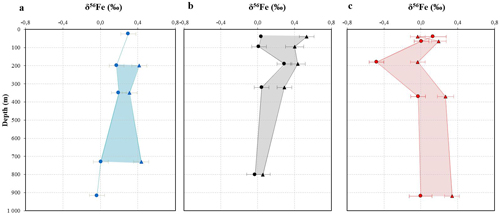Iron isotopes in the Equatorial Pacific Ocean: when the dissolved phases are heavier than the particulate ones
A detailed study of the dissolved and particulate iron (Fe) concentrations and isotopes off the Papua New Guinea coast is proposed. Regarding the sources, iron isotopic composition (δ56Fe) values reveal that the aerosols are heavier than the average crustal value while the sediments and river/volcano waters display δ56Fe similar to crustal values.
Surprisingly, all along the vertical profiles (down to 1000m) the dissolved phase is almost systematically heavier than the particulate one (see figure below). This likely reflects equilibrium exchanges between the dissolved and particulate iron. These interactions seem to result in a net non reductive release of dissolved iron. The intensity of this release suggests this process could play an important role on the global scale.

Figure. Dissolved (triangles) and particulate (circles) Fe isotopic composition profiles in ‰ in three different stations in the Western Equatorial Pacific Ocean: (a) in Vitiaz Strait, (b) close to the Papua New Guinea coast downstream the Sepik river, and (c) close to New Ireland coast. The difference between dissolved and particulate iron isotopic composition (Δ56FeDFe – PFe) is represented by the colored area. It shows that the dissolved phase is almost systematically heavier (more positive values) than the particulate one with Δ56FeDFe – PFe = + 0.27 ± 0.25‰ (2SD, n = 11). Click here to view the figure larger.
Reference:
Labatut, M., Lacan, F., Pradoux, C., Chmeleff, J., Radic, A., Murray, J. W., Poitrasson, F., Johansen, A. M., Thil, F. (2014). Iron sources and dissolved-particulate interactions in the seawater of the Western Equatorial Pacific, iron isotope perspectives. Global Biogeochemical Cycles, 28(10), 1044–1065. doi:10.1002/2014GB004928 Click here to view the paper.
